Abstract
Soil Organic Matter (SOM) plays a critical role in enhancing soil fertility, structure, and microbial activity, which are vital for sustainable agricultural productivity. This study conducts a comparative technical and environmental analysis of three widely used organic matter sources—animal manure, poultry manure, and vermicompost—using the Analytical Hierarchy Process (AHP). The criteria for evaluation include accessibility, organic matter content, fungal and nematode contamination risks, impacts on soil pH and electrical conductivity (EC), and nutrient supply potential.
The results indicate that while animal manure ranks highest in accessibility, vermicompost outperforms both animal and poultry manure in terms of organic matter content, fungal and nematode contamination risks, and nutrient supply. Vermicompost's ability to improve soil microbial activity and enhance soil structure without significantly raising EC or negatively affecting pH makes it the optimal choice. This is particularly relevant in ensuring environmental sustainability and reducing soil salinity and acidity.
Overall, vermicompost emerges as the most balanced and environmentally sustainable option for soil amendment, demonstrating its superior technical benefits and minimal environmental risks. Its nutrient-rich profile, ability to suppress harmful soil pathogens, and favorable influence on soil structure and microbial health make it the most effective organic matter source for enhancing soil quality and supporting sustainable agriculture.
Technical and Environmental Comparison of Common Soil Organic Matter Sources Using the AHP Method: Animal Manure, Poultry Manure, and Vermicompost
Introduction
Soil organic matter (SOM) is fundamental to maintaining soil health, fertility, and productivity. Its role extends beyond improving soil structure and water-holding capacity to regulating nutrient cycling and sustaining soil microbial activity (Al-Shammary, 2024).
However, the choice of organic matter sources remains a critical challenge, as it significantly impacts soil quality, crop productivity, and environmental sustainability. In agricultural systems worldwide, common sources of organic matter include animal manure, poultry manure, and vermicompost (Durán-Lara, 2020). Each of these materials has unique advantages and limitations concerning technical feasibility and environmental implications.
Animal manure, widely used due to its availability and nutrient-rich composition, has been shown to enhance soil structure and fertility. However, it often introduces challenges such as the potential for heavy metal contamination and greenhouse gas emissions (Pajura, 2024). Poultry manure, on the other hand, is recognized for its high nutrient content, particularly nitrogen and phosphorus, but poses risks related to its elevated salinity and potential pathogen load (Manogaran, 2022). Vermicompost, derived from the decomposition of organic matter by earthworms, has gained popularity for its balanced nutrient profile and ability to improve soil microbial activity, though its production process is time-intensive and resource-dependent (Hajam, 2023).
Incorporating organic amendments into soils is not solely a technical decision; it also demands careful consideration of environmental sustainability. Risks such as fungal contamination, nematode propagation, and adverse effects on soil pH and salinity must be assessed comprehensively. Moreover, ease of access and the potential to supply substantial organic matter must be balanced against these risks to ensure sustainable agricultural practices.
Given these complexities, decision-making frameworks like the Analytical Hierarchy Process (AHP) offer valuable tools for evaluating and ranking organic matter sources. AHP facilitates a structured comparison of alternatives based on multiple criteria, integrating expert opinions to derive quantitative priorities (Saaty, 1999). This method has been successfully applied in various agricultural studies, such as assessing fertilizer efficiency (Mulyono, 2021) and evaluating land-use practices (Seyedmohammadi, 2019).
This study aims to perform a technical and environmental comparison of three commonly used organic matter sources—animal manure, poultry manure, and vermicompost—using the AHP method. Seven key criteria were selected for this analysis: ease of access, organic matter provision, risk of fungal contamination, risk of nematode infestation, adverse effects on soil pH, adverse effects on soil salinity, and nutrient supply potential. Data were gathered from expert surveys conducted in Iran, targeting agricultural professionals familiar with organic amendment practices in local conditions. The results provide a robust framework for selecting the most suitable organic amendment based on technical and environmental considerations.
This paper contributes to the growing body of literature on sustainable soil management by integrating qualitative expert evaluations with quantitative ranking methods. It aims to guide farmers, agronomists, and policymakers in making informed decisions about organic amendment use, fostering both soil health and environmental stewardship.
References
1. Al-Shammary, A. A. G. (2024). Optimizing sustainable agriculture: A comprehensive review of agronomic practices and their impacts on soil attributes. Journal of Environmental Management, 364, 121487. https://doi.org/10.1016/j.jenvman.2024.121487
2. Durán-Lara, E. F. (2020). Natural Organic Compounds for Application in Organic Farming. Agriculture, 10(2), 41. https://doi.org/10.3390/agriculture10020041
3. Pajura, R. (2024). Composting municipal solid waste and animal manure in response to the current fertilizer crisis - a recent review. Science of the Total Environment, 912, 169221. https://doi.org/10.1016/j.scitotenv.2023.169221
4. Manogaran, M. D. (2022). A review on treatment processes of chicken manure. Cleaner and Circular Bioeconomy, 2, 100013. https://doi.org/10.1016/j.clcb.2022.100013
5. Hajam, Y. A. (2023). Environmental waste management strategies and vermi transformation for sustainable development. Environmental Challenges, 13, 100747. https://doi.org/10.1016/j.envc.2023.100747
6. Saaty, T. L. (1999). Basic theory of the analytic hierarchy process: How to make a decision. ResearchGate, 93(4). https://www.researchgate.net/publication/28285820_Basic_theory_of_the_analytic_hierarchy_process_How_to_make_a_decision
7. Mulyono, E. E. (2021). Organic material selection for soil amendment on mine reclamation with analytic hierarchy process. Environmental Quality Management. https://doi.org/10.1002/tqem.21807
8. Seyedmohammadi, J. (2019). Development of a model using matter element, AHP and GIS techniques to assess the suitability of land for agriculture. Geoderma, 352, 80–95. https://doi.org/10.1016/j.geoderma.2019.05.046
Materials and Methods
This section outlines the methodology used to evaluate the technical and environmental performance of three commonly used organic matter sources in agricultural soil amendment: manure, poultry litter, and vermicompost. The evaluation was carried out through the Analytic Hierarchy Process (AHP), which is a multi-criteria decision-making tool that facilitates comparison of alternatives based on multiple criteria. The methodology was designed to assess both the technical feasibility and the environmental impacts of each material under seven main criteria: accessibility, organic matter content, fungal contamination risk, nematode contamination risk, pH impact, electrical conductivity (EC) impact, and nutrient supply.
Selection of Materials
Based on initial surveys of 20 agricultural experts in Iran, five organic materials were identified as commonly used for soil organic matter (SOM) supplementation in agricultural fields and greenhouses: manure, poultry litter, vermicompost, humic acid, and molasses. However, for the purposes of this study, a subset of three materials) manure, poultry litter, and vermicompost ( was selected for detailed evaluation due to their widespread use and relevance in Iranian agriculture. The materials were compared based on technical and environmental characteristics to assist in selecting the optimal organic matter source.
Criteria Selection and Weighting
The evaluation criteria were chosen to represent both the agronomic benefits and environmental risks associated with the use of organic materials in soil amendment. Each criterion was weighted based on its importance, which was determined through expert surveys and literature review. The criteria include:
accessibility: This criterion evaluates how easily farmers can obtain the material, considering its availability and the logistical challenges of transportation. Materials that are readily accessible will receive higher scores.
Organic Matter Content: This factor assesses the percentage of organic matter in the material. For example, a material with 40% organic matter will score higher than one with only 20%.
fungal contamination risk: This criterion measures the risk of the material introducing fungal pathogens into the soil. Materials with a lower likelihood of fungal contamination will be rated more favorably.
Nematode contamination Risk: This factor evaluates the potential of the material to cause nematode infestations in the soil. Materials with minimal risk of nematode contamination will score higher.
Impact on Soil pH: This criterion examines how a material might negatively affect soil pH. Materials that have little to no adverse impact on soil pH will be awarded higher scores.
Impact on Electrical Conductivity (EC): This factor considers the potential of a material to increase soil salinity, as measured by electrical conductivity (EC). Materials with less impact on EC levels will be rated more favorably.
nutrient supply: This criterion assesses the material's nutrient profile, including its macro- and micronutrient content essential for plant growth. Materials with a higher nutrient density will receive better scores.
Each criterion was assigned a weight, reflecting its relative importance in the overall decision-making process. The weights for these criteria were derived from the literature and expert surveys.
Data Collection
Data for the comparison of materials was obtained from a survey of 10 agricultural experts who performed a pairwise comparison of the three selected organic materials against each criterion. The pairwise comparison matrix was constructed using a scale of 1 to 9, where 1 represents equal importance and 9 represents overwhelming importance of one material over another. The comparison matrix was then input into the Expert Choice software, which used AHP to calculate the local and global priorities of each material under each criterion.
The global priorities represent the overall ranking of each material, taking into account the weighted sum of the local priorities for each criterion. The consistency of the pairwise comparison matrix was also evaluated, with an inconsistency index calculated for each criterion. The results of the AHP analysis were used to rank the materials based on their technical and environmental performance.
AHP Methodology
The AHP methodology used in this study follows the standard procedure for pairwise comparison, consistency checking, and priority calculation (Saaty, 1987). The pairwise comparison matrix is synthesized to generate local priorities, which are then multiplied by the weights assigned to each criterion. This process generates a global priority vector, which reflects the overall ranking of materials based on the weighted criteria (Cicciù, 2022).
The consistency ratio (CR) is an important factor in determining the reliability of the pairwise comparisons. A CR value of less than 0.1 indicates acceptable consistency in the comparisons, while higher values may suggest inconsistencies that need to be addressed (Saaty, 1990). The inconsistencies for the criteria in this study were as follows: accessibility (0.2), organic matter content (0.02), fungal contamination risk (0.14), nematode contamination risk (0.22), pH impact (0.08), EC impact (0.18), and nutrient supply (0.22). A global inconsistency of 0.08 was found, indicating that the pairwise comparisons were generally consistent.
Software and Analysis
The analysis was conducted using Expert Choice software, a widely used tool for AHP analysis. The software was employed to facilitate the calculation of local and global priorities, as well as to check for consistency within the comparison matrices. The results were analyzed to determine the relative strengths and weaknesses of each material in terms of the defined criteria.
The materials were ranked based on their global priorities, with higher values indicating better overall performance. The findings were presented in both tabular and graphical formats for easier interpretation.
References:
- Saaty, R. W. (1987). The Analytic Hierarchy Process—what It Is and How It Is Used. Mathematical Modelling, 9(3-5), 161–176. https://doi.org/10.1016/0270-0255(87)90473-8
- Al-Shammary, A. A. G. (2024). Optimizing sustainable agriculture: A comprehensive review of agronomic practices and their impacts on soil attributes. Journal of Environmental Management, 364, 121487. https://doi.org/10.1016/j.jenvman.2024.121487
- Saaty, T. L. (1990). How to make a decision: The analytic hierarchy process. European Journal of Operational Research, 48(1), 9–26. https://doi.org/10.1016/0377-2217(90)90057-i
Results and Discussion
This study employed the Analytical Hierarchy Process (AHP) to evaluate the suitability of various organic matter sources, including animal manure, poultry litter, and vermicompost, as soil amendments. The AHP methodology facilitated a multi-criteria assessment considering technical and environmental factors such as accessibility, organic matter content, fungal and nematode contamination risks, effects on soil pH and electrical conductivity (EC), and nutrient supply. The analysis revealed distinct performances across these criteria, highlighting both the advantages and limitations of each organic matter source.
1. Accessibility:
The AHP results indicated that animal manure exhibited the highest accessibility, with a local weight of 0.309 and a global weight of 0.008. This high ranking can be attributed to its widespread availability in agricultural settings, particularly in rural areas (Lima, 2009). In contrast, vermicompost and poultry litter were deemed less accessible, with local weights of 0.156 and 0.152, respectively, and global weights of 0.004 and 0.004. These lower rankings are primarily due to the limited availability and specialized production requirements associated with these materials.
The higher accessibility of animal manure suggests its greater feasibility for widespread adoption in soil management practices, especially in developing agricultural systems. This finding aligns with previous research (Sobheh Nikmehr, 2024) that emphasizes the crucial role of accessibility in the selection of organic amendments for soil improvement.
2. Organic Matter Content:
When assessing the organic matter (OM) content, vermicompost and animal manure emerged as the top performers, with local weights of 0.345 and 0.330, respectively, and global weights of 0.029 and 0.028. These materials are characterized by high OM content, which is essential for enhancing soil fertility, improving soil structure, and promoting beneficial soil microbial activity (Morash, 2024). In contrast, poultry litter exhibited the lowest OM content with a local weight of 0.08 and a global weight of 0.007.
This finding corroborates research by Sa, Z. (2023), which highlights the critical role of organic matter in maintaining soil health by improving water retention capacity, nutrient availability, and overall microbial activity.
3. Fungal Contamination Risk:
When evaluating the risk of fungal contamination, vermicompost demonstrated a moderate risk, with a local weight of 0.168 and a global weight of 0.036. Vermicompost is recognized for its potential to suppress fungal diseases, likely due to its balanced microbial community. In contrast, manure and poultry litter showed higher contamination risks, with manure having a local weight of 0.040 and a global weight of 0.009, and poultry litter a local weight of 0.036 and a global weight of 0.008. These materials, due to their high organic content, can act as potential reservoirs for fungal spores.
These findings are consistent with studies indicating that proper composting and processing of organic amendments can significantly reduce fungal contamination risks (Elena Elisabeta Manea, 2024).
4.Nematode Contamination Risk:
Among the evaluated organic amendments, vermicompost demonstrated a relatively low risk of nematode contamination, with a local weight of 0.174 and a global weight of 0.065. This performance is attributed to its ability to suppress nematodes, largely due to the presence of earthworms, which contribute to creating a biologically balanced environment unfavorable for nematode populations (Singh, 2018). Animal manure, however, showed a higher risk, with a local weight of 0.023 and a global weight of 0.009, as its organic content provides a suitable breeding ground for nematodes (Nahar, 2006). Poultry litter also exhibited a notable risk, with a local weight of 0.053 and a global weight of 0.020, underscoring its potential as a nematode reservoir.
These findings align with research that emphasizes the importance of proper processing and composting techniques to mitigate the risk of nematode contamination in organic amendments (Nahar, 2006).
5. Effects on Soil pH:
In terms of soil pH, animal manure was found to have the least negative effect, with a local weight of 0.411 and a global weight of 0.034. It tends to slightly raise soil pH. Poultry litter also exhibited a moderate impact with a local weight of 0.257 and a global weight of 0.021, while vermicompost had lower local weights of 0.134 and a global weight of 0.011.
6. Effects on Soil EC:
The electrical conductivity (EC), an indicator of soil salinity, was least adversely impacted by vermicompost, reflecting its lower potential to contribute to soil salinity compared to other amendments, with a local weight of 0.184 and a global weight of 0.031, indicating a lower risk of increasing soil salinity. Animal manure (local weight: 0.052, global weight: 0.009) and poultry litter (local weight: 0.027, global weight: 0.004) exhibited higher risks of contributing to salinity, which is a critical factor for maintaining crop health.
7. Nutrient Supply:
The nutrient supply was highest in vermicompost (local weight: 0.400, global weight: 0.021) and poultry litter (local weight: 0.323, global weight: 0.017), which are rich in essential nutrients such as nitrogen, phosphorus, and potassium (Sinha, 2009). Animal manure provided a lower nutrient supply compared to these materials, with a local weight of 0.164 and a global weight of 0.009.
These findings corroborate research by Sinha (2009), which demonstrated that vermicomposts are excellent sources of plant nutrients due to their nutrient-rich organic matter content.

Analysis of the Chart
Nematode Dominance: The factor "Nematode" has the highest score, indicating that it is considered the most critical or influential factor among the evaluated criteria. This suggests that the presence or absence of nematodes is a significant determinant of the overall outcome.
Fungal Importance: "Fungi" holds the second-highest score, highlighting the importance of fungal presence or activity in the system being studied.
Variable Importance: The remaining factors, such as "Access," "OM" (likely referring to Organic Matter), "pH," "EC" (possibly Electrical Conductivity), and "Nutrients," have varying levels of importance. "Access" has the lowest score, suggesting it is the least influential factor.

Analysis of the Chart:
Vermicompost Dominance: Vermicompost emerges as the clear winner in this comparison, scoring the highest value of 0.581. This suggests that vermicompost is most aligned with the unspecified "Goal" when compared to the other two options.
Animal and Poultry Manure: Animal manure scores 0.225, indicating a moderate alignment with the goal, while poultry manure scores the lowest at 0.194.
Overall Consistency: The "Overall Inconsistency" value of 0.08 suggests a relatively high level of consistency among the expert judgments. This means that the experts who provided the data for this analysis had a fairly consistent understanding of how the different amendments compared to each other.
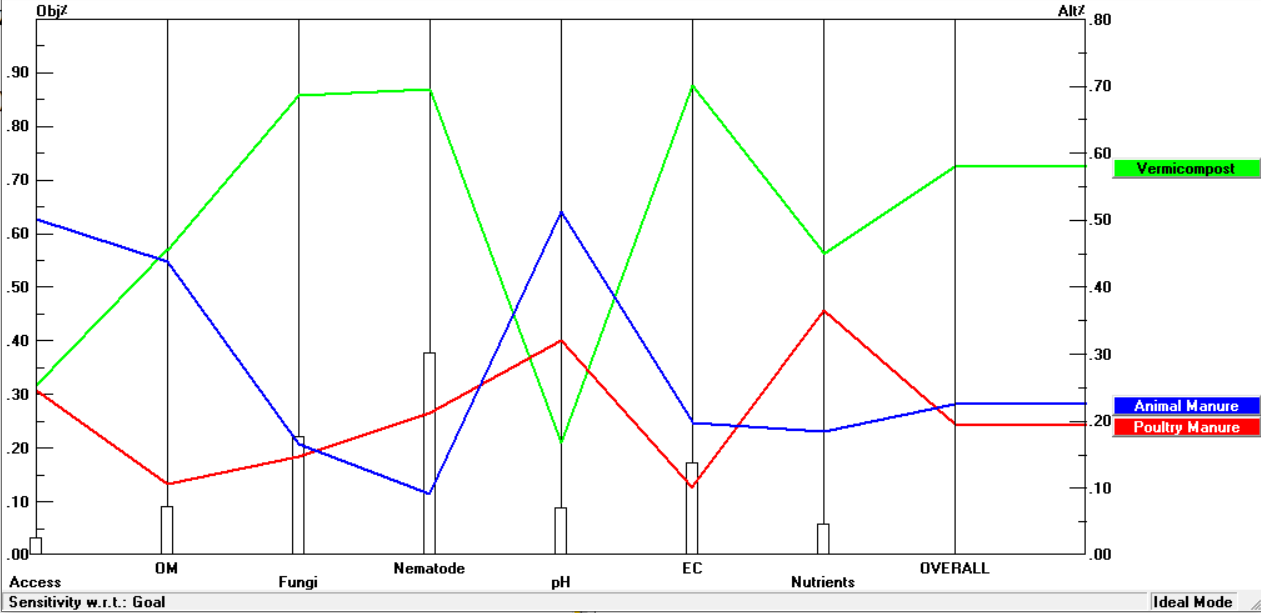
Analysis of the Chart:
This chart illustrates a sensitivity analysis with respect to the overall goal of selecting the best organic amendment among animal manure, poultry manure, and vermicompost. The different criteria evaluated include accessibility, organic matter (OM), fungal risk, nematode risk, pH, electrical conductivity (EC), and nutrient content. The vertical axis represents the relative performance (global weights) of each organic amendment on these criteria, and the overall performance is shown on the far-right column.
Key Observations:
- Overall Performance:
- Vermicompost (green line) ranks highest overall with a global weight of approximately 0.60, confirming its dominance in most criteria.
- Animal manure (blue line) follows with a weight of about 0.23, indicating it is a moderate performer across various factors.
- Poultry manure (red line) has the lowest overall weight of approximately 0.20, highlighting its relatively weaker performance.
- Criterion-Specific Analysis:
- Access:
- Animal manure performs best, reflecting its widespread availability and ease of use in agricultural systems.
- Vermicompost and poultry manure score lower, with vermicompost slightly outperforming poultry manure.
- Organic Matter (OM):
- Vermicompost excels due to its high organic matter content, making it the most effective for improving soil fertility.
- Animal manure has moderate performance, while poultry manure scores lowest.
- Fungal Risk:
- Vermicompost performs best, indicating minimal fungal contamination risks.
- Animal manure has a moderate fungal risk, while poultry manure exhibits the highest risk of fungal contamination.
- Nematode Risk:
- Vermicompost again leads as the safest option with minimal nematode contamination.
- Poultry manure shows a slightly higher risk, and animal manure has the highest nematode contamination risk.
- pH:
- Vermicompost achieves a balanced performance, indicating a neutral or slightly favorable pH level.
- Poultry manure and animal manure perform similarly, but with slightly lower scores.
- Electrical Conductivity (EC):
- Vermicompost has the lowest EC, which is ideal for maintaining soil salinity within acceptable ranges.
- Poultry manure exhibits the highest EC, indicating a risk of salinity buildup, while animal manure shows moderate performance.
- Nutrient Content:
- Poultry manure scores highest due to its strong nutrient provision, followed by vermicompost with slightly lower nutrient content.
- Animal manure ranks lowest in this category.
- Access:
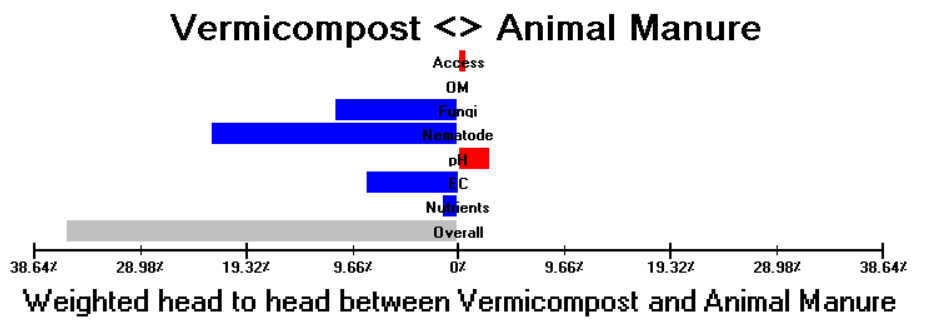
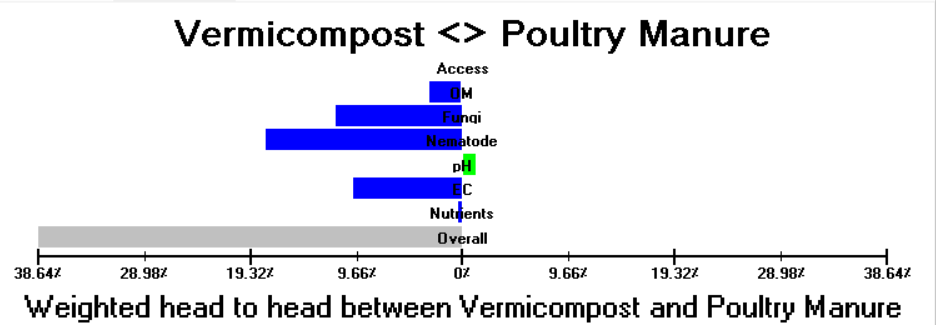
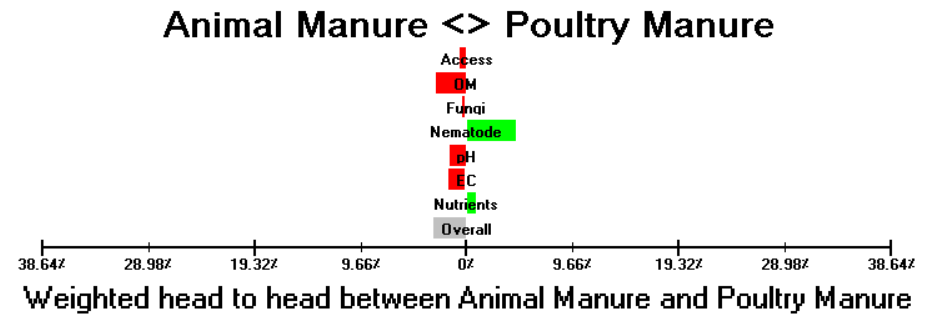
Conclusion:
In conclusion, this study provides a comparative analysis of three commonly used organic amendments—animal manure, poultry litter, and vermicompost—for enhancing soil organic matter using the Analytical Hierarchy Process (AHP). The findings indicate that each material has distinct strengths and weaknesses based on technical and environmental criteria.
Animal Manure demonstrates the highest accessibility, making it a practical choice for widespread use, especially in resource-constrained agricultural systems. It performs well in availability and cost-effectiveness, but its moderate performance in nutrient content and risk of contamination limits its overall appeal.
Poultry Manure provides strong nutrient content, making it a good source of plant-available nutrients. However, its higher risks of fungal and nematode contamination, along with its potential to increase soil salinity, make it less favorable for sustainable use compared to the other options.
Vermicompost emerges as the most balanced option, excelling in organic matter content, nutrient supply, and its ability to minimize contamination risks. Additionally, its environmentally friendly nature and ability to improve soil health make it the most sustainable and effective amendment.
Weight-Based Ranking:
Based on the global weights calculated through AHP, the overall ranking of the three amendments is as follows:
- Vermicompost (0.581): The highest-scoring option, offering a sustainable and effective solution for improving soil fertility and health.
- Animal Manure (0.225): A cost-effective and accessible amendment, suitable for large-scale use but less optimal in certain technical and environmental aspects.
- Poultry Manure (0.194): While offering good nutrient supply, it ranks lowest due to contamination risks and its negative effects on soil properties like salinity.
Final Recommendation:
While animal manure remains a viable and economical choice for many agricultural systems, and poultry manure can provide quick nutrient availability, vermicompost is recommended as the optimal amendment due to its superior global weight and balanced performance across all criteria. Future research should explore advanced production techniques for vermicompost to enhance its scalability and cost-effectiveness. Additionally, further studies should focus on mitigating the limitations of animal and poultry manures, such as contamination risks and salinity issues, to make them more suitable for sustainable agriculture.
This ranking provides a framework for decision-making in selecting the most appropriate organic amendment, depending on the specific needs and constraints of agricultural systems.
References
1. Lima, D. L. D. (2009). Effects of organic and inorganic amendments on soil organic matter properties. Geoderma, 150(1-2), 38–45. https://doi.org/10.1016/j.geoderma.2009.01.009
2. Sobheh Nikmehr. (2024). Improving soil fertility and moisture with organic amendments in arid regions. Elsevier EBooks, 333–364. https://doi.org/10.1016/b978-0-443-23956-4.00021-1
3. Sa, Z. (2023, August 20). THE IMPORTANCE OF SOIL ORGANIC MATTER (SOM) ON SOIL PRODUCTIVITY AND PLANT GROWTH. ResearchGate; Medeye Publishers. https://www.researchgate.net/publication/373237773_THE_IMPORTANCE_OF_SOIL_ORGANIC_MATTER_SOM_ON_SOIL_PRODUCTIVITY_AND_PLANT_GROWTH
4. Elena Elisabeta Manea. (2024). Composting as a Sustainable Solution for Organic Solid Waste Management: Current Practices and Potential Improvements. Sustainability, 16(15), 6329–6329. https://doi.org/10.3390/su16156329
5. Nahar, M. S. (2006). Differential effects of raw and composted manure on nematode community, and its indicative value for soil microbial, physical and chemical properties. Applied Soil Ecology, 34(2-3), 140–151. https://doi.org/10.1016/j.apsoil.2006.03.011
6. Sinha, R. (2009). Earthworms Vermicompost: A Powerful Crop Nutrient over the Conventional Compost & Protective Soil Conditioner against the Destructive Chemical Fertilizers for Food Safety and Security. American-Eurasian Journal of Agricultural & Environmental Sciences, 5(Suppl.), 14–22. http://hdl.handle.net/10072/30336

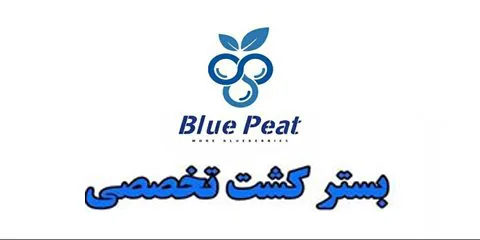


دیدگاه خود را بنویسید